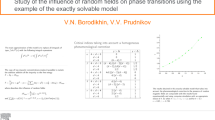Abstract
We present a simple approximation for dynamical correlation functions in stochastic systems which reproduces the high as well as the low frequency behaviour of the exact correlation functions. The approximation is applied in its lowest order to diffusion in a quartic potential and to autocatalytic chemical reaction systems as described by the Schlögl models. The results are compared to those from the conventional Mori-Zwanzig projection operator approach which reproduces only the short-time relaxation of the systems considered. The new approximation describes correctly slow relaxation processes, e.g. barrier crossing in a quartic potential and the slowing down of dynamic processes in finite autocatalytic systems near first and second order transitions.
Similar content being viewed by others
References
Wiegel, F.W.: Phys. Rep.95, 283 (1983)
McCammon, J.A.: Rep. Prog. Phys.47, 1 (1984)
Northrup, S.H., Hynes, J.T.: J. Chem. Phys.69, 5246 (1978)
Gardiner, C.W.: Handbook of Stochastic Methods. Berlin, Heidelberg, New York: Springer 1983
Pomeau, Y., Résibois, P.: Phys. Rep.19, 63 (1975)
Hohenberg, P.C., Halperin, B.I.: Rev. Mod. Phys.49, 435 (1977)
Mori, H.: Prog. Theor. Phys.34, 399 (1965)
Zwanzig, R.: In: Lect. Theor. Phys. Brittin, W., Dunham, L. (eds.), Vol. 3, p. 135, New York: Wiley 1961
Schulten, K., Brünger, A., Nadler, W., Schulten, Z.: In: Synergetics — from Microscopic to Macroscopic Order. Frehland, E. (ed.), p. 80. Berlin, Heidelberg, New York, Tokyo: Springer 1984
Nadler, W., Schulten, K.: J. Chem. Phys. (in press)
Szabo, A., Schulten, K., Schulten, Z.: J. Chem. Phys.72, 4350 (1980)
Schulten, K., Schulten, Z., Szabo, A.: J. Chem. Phys.74, 4426 (1981)
An early, though not systematic, attempt to apply the ideas of generalized moment expansion to optical bistability has been made in Della Donne, M., Richter, P.H., Ross, J.: Z. Phys. B — Condensed Matter42, 271 (1981)
Schlögl, F.: Z. Phys.253, 147 (1972)
Hänggi, P., Rösch, F., Trautmann, D.: Z. Naturforsch.33a, 402 (1978)
Hänggi, P.: Z. Naturforsch.33a, 1380 (1978)
Grossmann, S., Schranner, R.: Z. Phys. B — Condensed Matter and Quanta30, 325 (1978)
The evaluation of the inverse operator poses no problems in principle since δM does not belong to the kernel of L+
Baker, G.A., Graves-Morris, P.: Padé-approximants. Vol. 2. Reading: Addison-Wesley 1981
Risken, H.: The Fokker Planck equation. Berlin, Heidelberg, New York, Tokyo: Springer 1984
Nadler, W., Schulten, K.: Phys. Rev. Lett.51, 1712 (1983)
Brünger, A., Schulten, K.: J. Chem. Phys. (in press)
Palmer, R.G., Stein, D.L., Abrahams, E., Anderson, P.W.: Phys. Rev. Lett.53, 958 (1984)
Coleman, S.: In: Laws of hadronic matter. Zichichi, A. (ed.), p. 138. New York: Plenum 1973
Dekker, H., Kampen, N.G. van: Phys. Lett.73A, 374 (1979)
Kampen, N.G. van: J. Stat. Phys.17, 71 (1977)
Bernstein M., Brown, L.S.: Phys. Rev. Lett.52, 1933 (1984)
Kramers, H.A.: Physica7, 284 (1940)
Janssen, H.K.: Z. Phys.270, 67 (1974)
Vvedensky, D.D., Elderfield, D.J., Chang, T.S.: J. Phys.17A, L423 (1984)
Actually there is no transition at κ=0 in the stochastic model sinceN=0 becomes an absorbing state
Jähnig, F., Richter, P.H.: J. Chem. Phys.64, 4645 (1976)
This relationship can be obtained using the generating function for the moments of the probability distribution given in Jähnig, F., Richter, P.H.: Ber. Bunsengesellsch. Phys. Chem.80, 1132 (1976)
Barber, N.M.: In: Phase transitions and critical phenomena. Domb, C., Lebowitz, J.L. (eds.), Vol. 8, p. 145. London: Academic Press 1983
Grossmann and Schranner questioned the validity of the relationship λ1∼Ω−1/2. Their argument is that. — derived λ1∼exp(−Ω). But Janssen's derivation of this relation only which is true solely fora>3. Since long-and short-time approximation converge in the limit Ω→∞ we regard the relationship λ1∼Ω−1/2 to be correct
Lebedev, N.N.: Special functions and their applications, p. 29, Problem 6. Englewood Cliffs: Prentice Hall 1965
Author information
Authors and Affiliations
Rights and permissions
About this article
Cite this article
Nadler, W., Schulten, K. Mean relaxation time approximation for dynamical correlation functions in stochastic systems near instabilities. Z. Physik B - Condensed Matter 59, 53–61 (1985). https://doi.org/10.1007/BF01325382
Received:
Issue Date:
DOI: https://doi.org/10.1007/BF01325382




